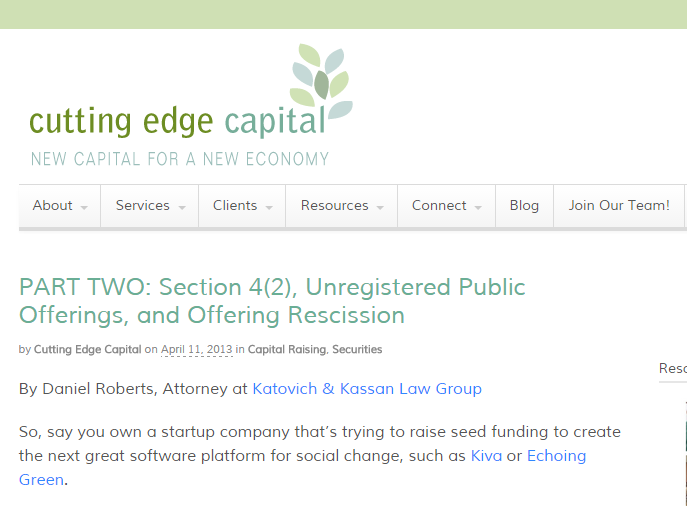

So, say you own a startup company that’s trying to raise seed funding to create the next great software platform for social change, such as Kiva or Echoing Green.
You’ve exhausted all your personal finances, maxed out your credit cards. You’ve already taken on some investment capital from family and friends—now it’s time to really scale and hire a bunch of software designers, developers, and other employees to turn your brainchild into reality. Where can you find $5 million to achieve this next phase of growth? You search your networks, but you’re only 90% successful. You realize that although you’ve secured $4.5 million from the accredited investors in your network, you’re not going to get that last $500,000 without taking on non-accredited investors.
Rule 506 and Non-Accredited Investors
It is completely legal to sell equity security interests in a private placement to non-accredited investors who meet the requirements under Regulation D.[1] However, selling to non-accredited investors triggers an additional (and very onerous) disclosure requirement[2]—and there must be no more than 35 of them.
But what happens if you just happen to sell to too many non-accredited investors, or otherwise fail to meet the requirements of the Rule 506 Safe Harbor?
Under federal law, even if an offering exceeds the Rule 506 Safe Harbor, it may still conform to the broad exemption of Section 4(2) of the 1933 Act, which exempts from registration “transactions by an issuer not involving any public offering.” The legal lines of what defines a “public offering” are not tightly drawn.[3] If the offering really wasn’t a private offering, investors may have a federal rescission right under Section 12 of the 1933 Act.
At the state level, the result of failing to meet the requirements of Rule 506 is that the registration exemption provided by Rule 506 no longer applies. Without the safe harbor exemption, an issuer must analyze the offering in the context of the laws of each of the states where the securities were sold.
Just like under federal law, a sale of securities must be registered with state regulators—unless an exemption from registration applies. In some states, limited offering exemptions may apply if securities were only sold or offered to a small number of investors.[4] In such cases, an issuer may never have to register the securities or face penalties from the regulators, and may only be required to file notice with the state. If no state registration exemption is available, an issuer may be able to file a registration statement with the state securities regulator retroactively. Even so, an issuer may still face administrative fines or other penalties at the state level for offering and selling securities in the absence of a valid registration.
If an issuer has sold securities illegally, and there is no way to make the sale legitimate after the fact, the issuer can be held liable to investors who bought the unregistered securities. Under many state laws, the only way to “clean up” the problem of having sold unregistered securities is by offering investors the right to rescind their investment.
The legal term “rescission” simply means an undoing or cancelling of a transaction. In the context of securities law, it means offering an investor back the money she paid to buy the securities, plus interest. Offering an investor the option to rescind his or her investment will in most cases extinguish the investor’s right to sue the issuer for failing to properly register the securities.[5] Although a rescission offer may extinguish civil liability as to the investor, it does not necessarily extinguish enforcement liability as to the regulators. Even so, regulators whose job it is to protect their constituents, generally favor voluntary rescission offers and will tend not to prosecute the underlying misstep in the absence of outright fraud.
A rescission offer can be a useful tool to avoid liability to shareholders not only when a company may have violated the securities registration requirements, but also if it has provided investors with misinformation or omitted material information. Practitioners should be forewarned however, that a rescission offer will often be considered an offer of securities. In such instances, rescission offers must conform to the registration requirements of state and federal law, and may require the submission of a prospectus with updated financial statements to regulators prior to making the offer. In some states, the securities regulators provide simple form-letters for offering rescission, which greatly simplify the process.[6]
Generally speaking, offering rescission can be an extensive process, often requiring the prior approval of regulators before offers can be made to a company’s investors. The drain on resources can be immense and time consuming—whether or not investors choose to accept their money back. If there is a lesson to be learned here, it is to follow the rules when selling securities privately—the first time through.
[1] 17 CFR 230.506, N. 2. “Each purchaser who is not an accredited investor either alone or with his purchaser representative(s) has such knowledge and experience in financial and business matters that he is capable of evaluating the merits and risks of the prospective investment, or the issuer reasonably believes immediately prior to making any sale that such purchaser comes within this description.”
[2] Under Rule 506, companies must give non-accredited investors disclosure documents that are generally the same as those used in registered offerings. (See 17 C.F.R. § 230.502(B)(2)). If a company provides information to accredited investors, it must make this information available to non-accredited investors as well.
[3] In Securities and Exchange Commission v. Ralson Purina, 346 U.S. 119 (1953), the Supreme Court laid out the factors that more clearly define what constitutes a public offering.
[4] For example, Colorado exempts offerings to fewer than 20 investors. Colorado Securities Act, § 11-51-308.
[5] See Model Uniform Securities Act, Section 510.